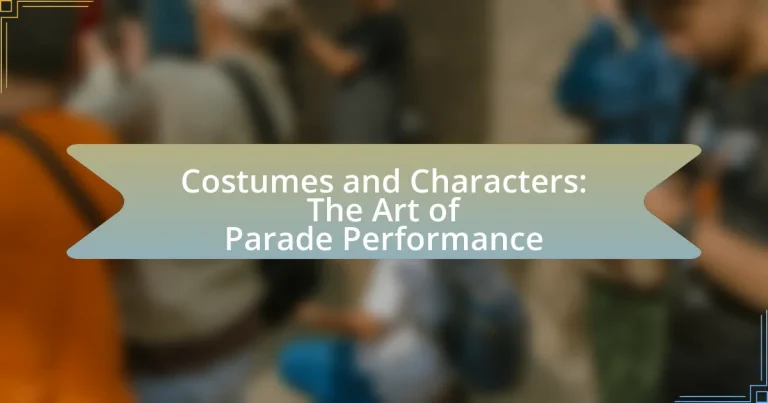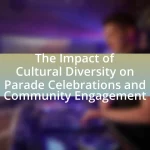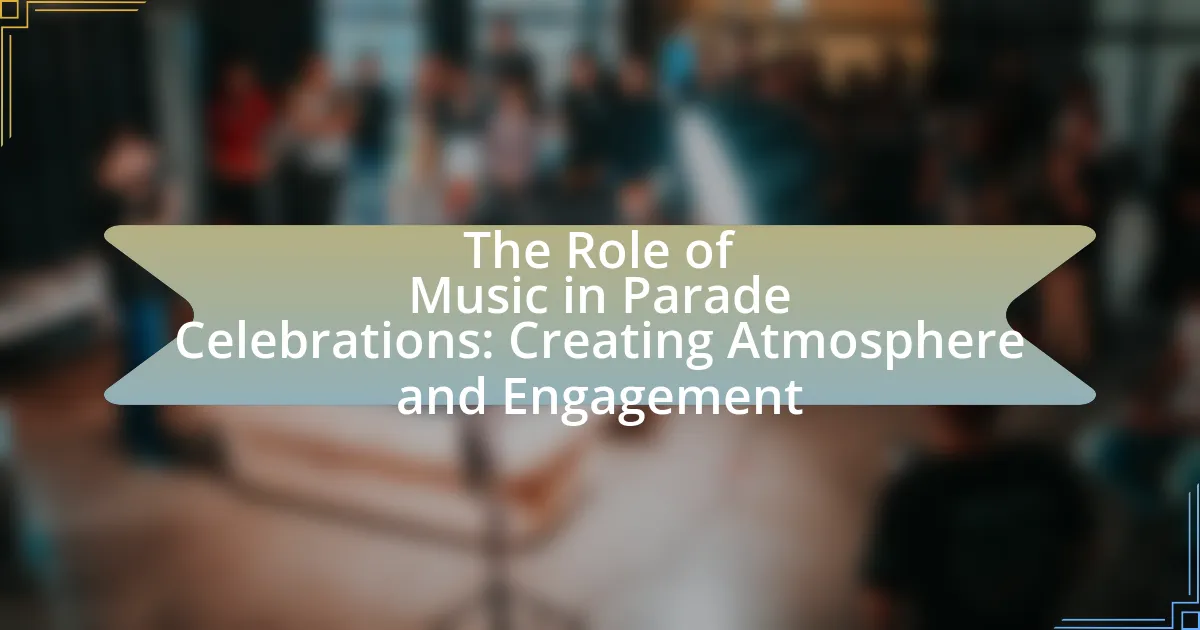Costumes and characters are fundamental components of parade performances, enhancing visual storytelling and thematic representation. This article explores the significance of costumes in conveying cultural narratives, the materials commonly used in their design, and the impact of colors and designs on audience perception. It also examines the role of characters in engaging spectators, the development process for specific parades, and the various types of characters typically featured. Additionally, the article highlights the importance of parade performance in reflecting cultural identity, promoting community engagement, and the skills necessary for effective execution, while addressing challenges in costume design and character portrayal. Best practices for creating functional and visually appealing costumes, as well as techniques for engaging audiences, are also discussed.
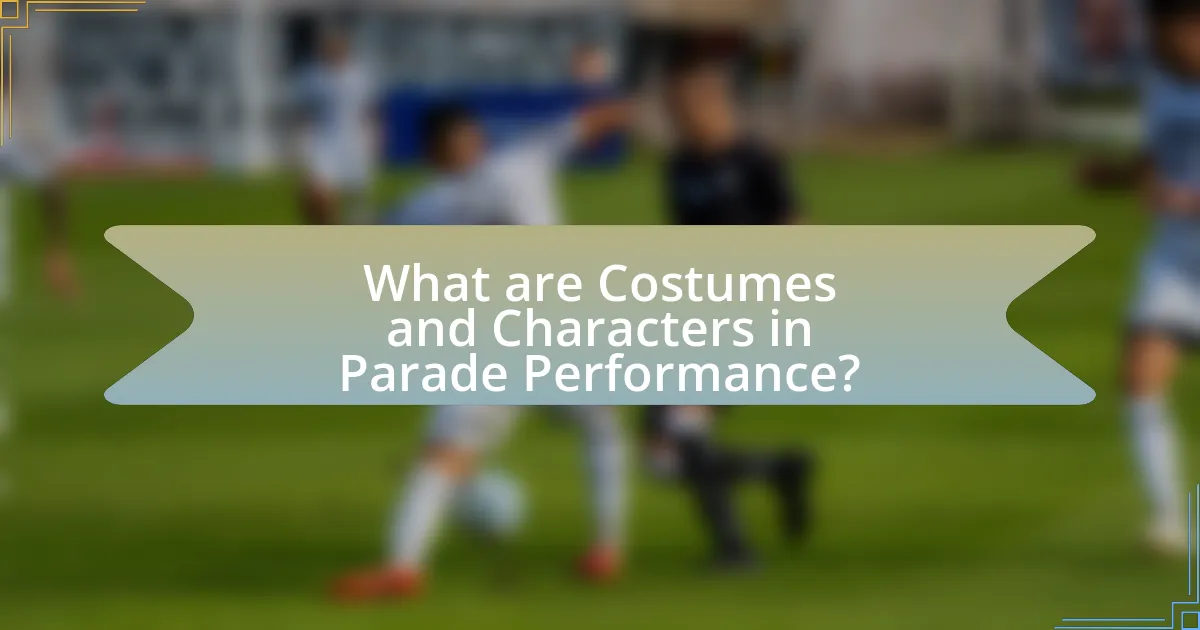
What are Costumes and Characters in Parade Performance?
Costumes and characters in parade performance are essential elements that enhance the visual spectacle and thematic storytelling of the event. Costumes are meticulously designed outfits that represent various themes, cultures, or characters, often incorporating vibrant colors, intricate patterns, and unique materials to captivate the audience. Characters, on the other hand, are the personas portrayed by performers, which can range from historical figures to fantastical creatures, each contributing to the overall narrative and atmosphere of the parade. The combination of these costumes and characters creates an immersive experience, engaging spectators and fostering a sense of community and celebration.
How do costumes contribute to the overall theme of a parade?
Costumes significantly enhance the overall theme of a parade by visually representing the central ideas and cultural narratives being celebrated. They serve as a medium for storytelling, allowing participants to embody characters or concepts that align with the parade’s theme, such as historical events, cultural traditions, or seasonal festivities. For instance, during Mardi Gras, elaborate costumes reflect the festival’s vibrant spirit and cultural heritage, reinforcing the celebratory atmosphere. Additionally, costumes can create a cohesive visual experience, as seen in events like the Rose Parade, where floral-themed attire complements the floral floats, thereby strengthening the thematic unity of the entire event.
What materials are commonly used in parade costumes?
Parade costumes commonly utilize materials such as polyester, sequins, feathers, and foam. Polyester is favored for its durability and vibrant colors, making it ideal for elaborate designs. Sequins add sparkle and visual interest, enhancing the overall aesthetic of the costume. Feathers are often used for their lightweight and dramatic effect, while foam provides structure and can be shaped into various forms, allowing for creative designs. These materials collectively contribute to the visual impact and functionality required in parade performances.
How do colors and designs influence audience perception?
Colors and designs significantly influence audience perception by evoking emotions and shaping interpretations of visual stimuli. For instance, warm colors like red and yellow can create feelings of excitement and energy, while cool colors such as blue and green often evoke calmness and tranquility. Research indicates that color can affect mood and behavior; a study published in the journal “Color Research and Application” found that colors can influence consumer decisions, with 85% of consumers making purchasing decisions based on color alone. Additionally, design elements such as symmetry and balance can enhance visual appeal, leading to positive perceptions of the overall presentation. In the context of parade performances, vibrant colors and intricate designs can captivate audiences, enhancing their emotional engagement and overall experience.
What role do characters play in parade performances?
Characters in parade performances serve as essential elements that enhance storytelling and engage the audience. They embody themes, cultural narratives, and festive spirits, often representing historical figures, folklore, or community values. For instance, in the Macy’s Thanksgiving Day Parade, characters like Santa Claus symbolize holiday cheer and tradition, drawing crowds and fostering a sense of community. Additionally, characters contribute to the visual spectacle through elaborate costumes and choreography, creating a dynamic experience that captivates viewers. Their presence not only entertains but also educates the audience about cultural heritage and social messages, reinforcing the significance of the parade within the community.
How are characters developed for specific parades?
Characters for specific parades are developed through a collaborative process involving theme selection, design conceptualization, and performance planning. The development begins with identifying the parade’s theme, which guides the character’s visual and narrative elements. Designers create costumes and props that align with this theme, ensuring that each character embodies the intended message or story. Additionally, choreographers work with performers to develop movements and interactions that enhance the character’s presence during the parade. This process often includes feedback from various stakeholders, including event organizers and community representatives, to ensure cultural relevance and audience engagement.
What are the different types of characters typically seen in parades?
Parades typically feature a variety of characters, including floats, mascots, dancers, musicians, and themed performers. Floats are elaborately decorated vehicles that often represent specific themes or organizations, showcasing creativity and artistry. Mascots, often oversized and cartoonish, engage with the crowd and promote brands or teams. Dancers perform choreographed routines, adding energy and movement to the parade, while musicians provide live entertainment, enhancing the festive atmosphere. Themed performers, such as historical figures or cultural representations, contribute to the narrative and visual appeal of the parade. These character types are integral to the overall experience, creating a vibrant and engaging environment for spectators.
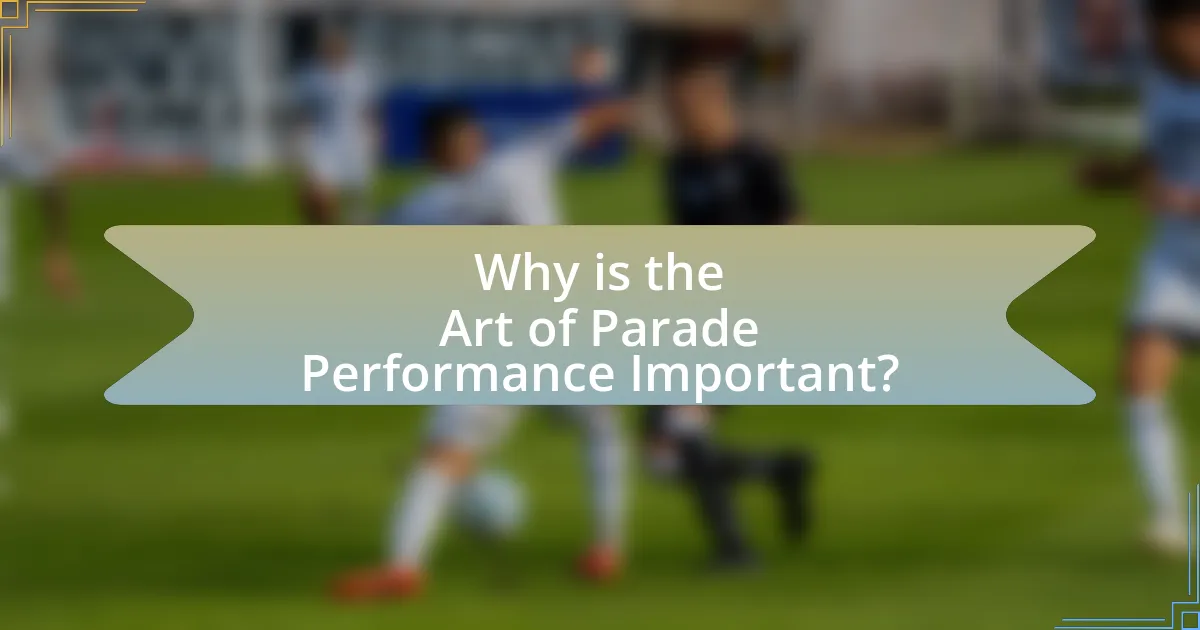
Why is the Art of Parade Performance Important?
The art of parade performance is important because it serves as a vibrant expression of culture and community identity. Parade performances engage audiences through visual storytelling, showcasing elaborate costumes and characters that reflect historical, social, and artistic narratives. For instance, events like the Macy’s Thanksgiving Day Parade attract millions of viewers, highlighting the significance of parades in fostering community spirit and cultural pride. Additionally, studies show that participation in parades can enhance social cohesion and promote local tourism, further underscoring their value in society.
How does parade performance reflect cultural identity?
Parade performance reflects cultural identity by showcasing traditional costumes, music, and dance that embody the values, beliefs, and history of a community. These elements serve as visual and auditory representations of cultural heritage, allowing participants and spectators to connect with their roots. For instance, the vibrant costumes worn during Carnival parades in Brazil highlight African, Indigenous, and European influences, illustrating the country’s diverse cultural tapestry. Additionally, the incorporation of specific symbols and motifs in parade performances often conveys stories and traditions unique to that culture, reinforcing a sense of belonging and pride among community members.
What historical significance do parades hold in various cultures?
Parades hold significant historical importance across various cultures as they serve as expressions of community identity, celebration of cultural heritage, and demonstrations of social and political power. For instance, ancient Roman triumphal parades celebrated military victories, showcasing the might of the empire and reinforcing social hierarchies. In many Indigenous cultures, parades are integral to rituals and festivals, symbolizing spiritual beliefs and community cohesion. The Mardi Gras celebrations in New Orleans exemplify how parades blend cultural traditions, music, and costumes, reflecting the city’s diverse heritage. Additionally, modern parades, such as Pride parades, highlight social movements and advocate for rights, illustrating how parades can evolve to address contemporary issues while maintaining their historical roots.
How do parades promote community engagement and pride?
Parades promote community engagement and pride by bringing together diverse groups of people to celebrate shared values and cultural heritage. This collective participation fosters a sense of belonging and unity among residents, as evidenced by events like the Macy’s Thanksgiving Day Parade, which attracts millions of spectators and participants each year, reinforcing local identity and community spirit. Additionally, parades often feature local organizations, schools, and businesses, which enhances community involvement and showcases local talent, further solidifying pride in the community.
What skills are essential for creating effective parade performances?
Essential skills for creating effective parade performances include choreography, costume design, and teamwork. Choreography is crucial as it dictates the movement and flow of the performance, ensuring that participants are synchronized and engaging. Costume design enhances the visual appeal and thematic representation of the parade, making it memorable for the audience. Teamwork is vital, as successful performances rely on collaboration among performers, designers, and organizers to execute the vision cohesively. These skills collectively contribute to a parade’s overall impact and success.
How do performers train for their roles in parades?
Performers train for their roles in parades through a combination of physical conditioning, choreography practice, and character development. Physical conditioning enhances stamina and strength, essential for enduring long hours of performance. Choreography practice involves learning specific movements and formations that align with the parade’s theme, often requiring repetition to achieve precision. Character development focuses on embodying the persona they represent, which may include vocal training, facial expressions, and interaction with the audience. This multifaceted training approach ensures that performers can deliver an engaging and cohesive performance that aligns with the parade’s artistic vision.
What are the challenges faced in costume design and character portrayal?
Costume design and character portrayal face several challenges, including budget constraints, material limitations, and the need for historical accuracy. Budget constraints often restrict the quality and quantity of materials that can be used, impacting the overall aesthetic and functionality of costumes. Material limitations can affect the comfort and mobility of performers, as certain fabrics may not withstand the rigors of performance. Additionally, achieving historical accuracy is crucial for authenticity, requiring extensive research and attention to detail, which can be time-consuming and complex. These challenges necessitate a balance between creativity and practicality in the design process.
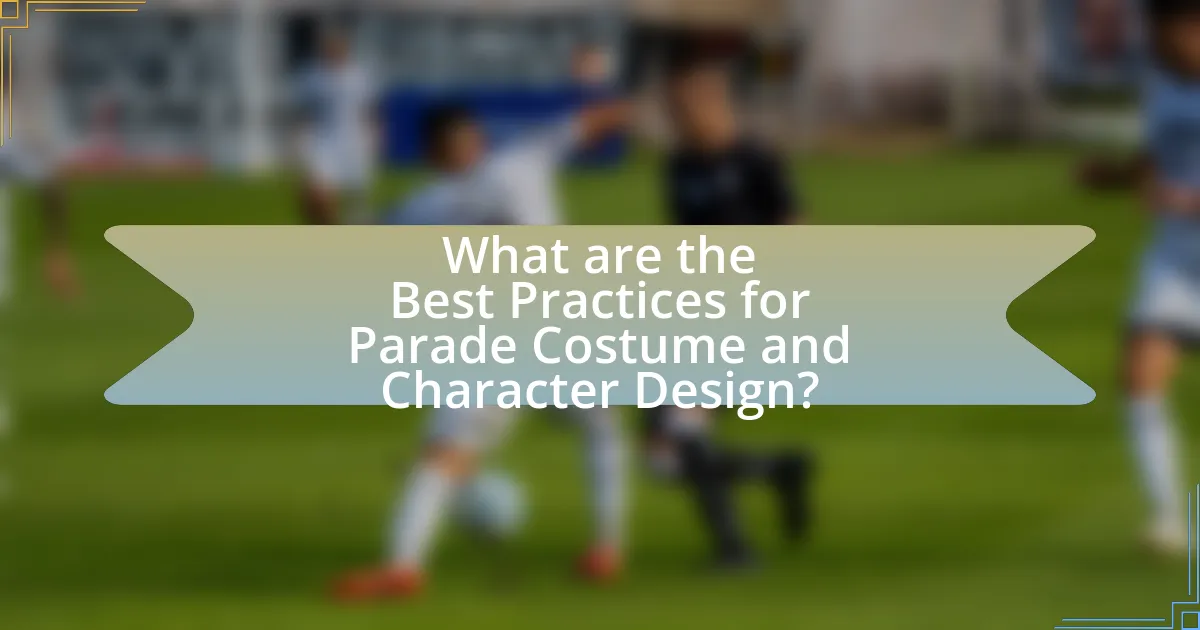
What are the Best Practices for Parade Costume and Character Design?
The best practices for parade costume and character design include ensuring visibility, comfort, and thematic coherence. Visibility is crucial as costumes must stand out in large crowds; using bright colors and reflective materials enhances this aspect. Comfort is essential for performers who may wear costumes for extended periods; lightweight fabrics and proper ventilation can prevent fatigue. Thematic coherence ensures that costumes align with the parade’s overall theme, creating a unified visual experience. For instance, the Rose Parade emphasizes floral designs, which are integral to its identity. These practices are supported by industry standards that prioritize performer safety and audience engagement, making them essential for successful parade presentations.
How can designers ensure costumes are both functional and visually appealing?
Designers can ensure costumes are both functional and visually appealing by integrating practical materials with aesthetic design elements. For instance, using lightweight, breathable fabrics allows for ease of movement while maintaining visual impact through vibrant colors and intricate patterns. Additionally, incorporating adjustable features, such as elastic bands or Velcro, enhances functionality without compromising the overall look. Research indicates that costumes designed for performance must balance mobility and visual appeal to meet the demands of dynamic environments, as seen in successful parade performances where functionality directly influences the performers’ ability to engage with the audience effectively.
What considerations should be made for comfort and mobility in costumes?
Costumes should prioritize breathable materials and ergonomic designs to ensure comfort and mobility. Breathable fabrics like cotton or moisture-wicking blends allow for airflow, reducing overheating during performances. Ergonomic designs, which include features like adjustable straps and flexible seams, enable ease of movement, allowing performers to engage in dynamic actions without restriction. Additionally, costumes should be tailored to fit the individual, as proper sizing minimizes discomfort and enhances mobility. Research indicates that performers wearing well-fitted costumes experience less fatigue and perform better, highlighting the importance of these considerations in costume design for parade performances.
How can sustainability be incorporated into costume design?
Sustainability can be incorporated into costume design by utilizing eco-friendly materials, repurposing existing garments, and implementing ethical production practices. Designers can choose organic fabrics, recycled materials, and low-impact dyes to minimize environmental impact. For instance, using fabrics made from recycled plastic bottles reduces waste and conserves resources. Additionally, repurposing costumes from previous productions or sourcing second-hand clothing can significantly decrease the demand for new materials. Ethical production practices, such as ensuring fair labor conditions and reducing carbon footprints during manufacturing, further enhance sustainability in costume design. These approaches not only contribute to environmental conservation but also promote social responsibility within the fashion industry.
What tips can enhance the portrayal of characters during a parade?
To enhance the portrayal of characters during a parade, performers should focus on vivid costumes, expressive body language, and engaging interactions with the audience. Vivid costumes, designed with bright colors and intricate details, capture attention and convey the character’s personality effectively. Expressive body language, including exaggerated movements and facial expressions, helps to communicate emotions and intentions clearly, making the character more relatable. Engaging interactions with the audience, such as eye contact, gestures, and inviting participation, create a memorable experience and foster a connection between the character and spectators. These elements collectively contribute to a dynamic and impactful portrayal during parades.
How can performers effectively engage with the audience?
Performers can effectively engage with the audience by utilizing interactive elements, maintaining eye contact, and adapting their performance based on audience reactions. Interactive elements, such as inviting audience participation or incorporating relatable themes, create a connection that enhances engagement. Maintaining eye contact fosters a sense of intimacy and involvement, making the audience feel personally addressed. Adapting performances in real-time, such as responding to audience laughter or applause, demonstrates attentiveness and encourages further interaction. Research indicates that performers who actively engage with their audience can increase overall satisfaction and enjoyment, leading to a more memorable experience.
What techniques can be used to bring characters to life on parade day?
To bring characters to life on parade day, techniques such as dynamic movement, expressive facial expressions, and engaging storytelling are essential. Dynamic movement involves choreographed routines that allow characters to interact with the audience, creating a lively atmosphere. Expressive facial expressions enhance the character’s personality and help convey emotions, making them relatable to spectators. Engaging storytelling through dialogue or visual narratives adds depth to the characters, allowing the audience to connect with them on a personal level. These techniques are supported by the fact that successful parades often rely on the ability of performers to captivate and entertain, as evidenced by events like the Macy’s Thanksgiving Day Parade, where character engagement significantly enhances viewer experience.
